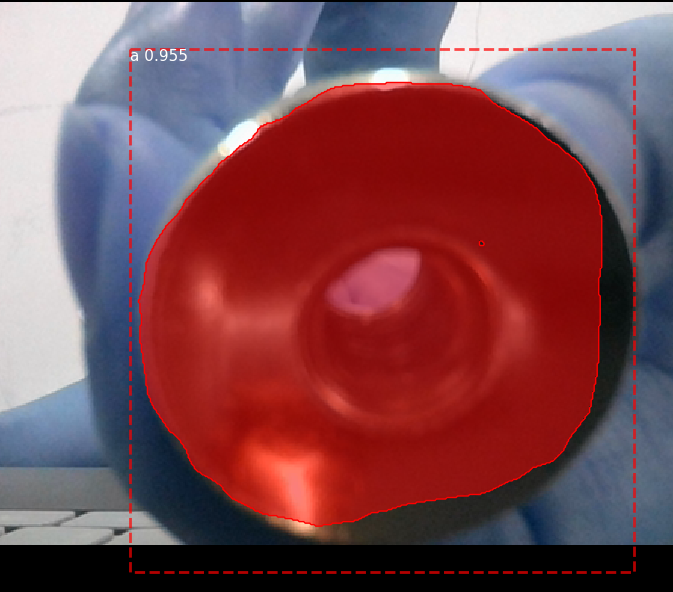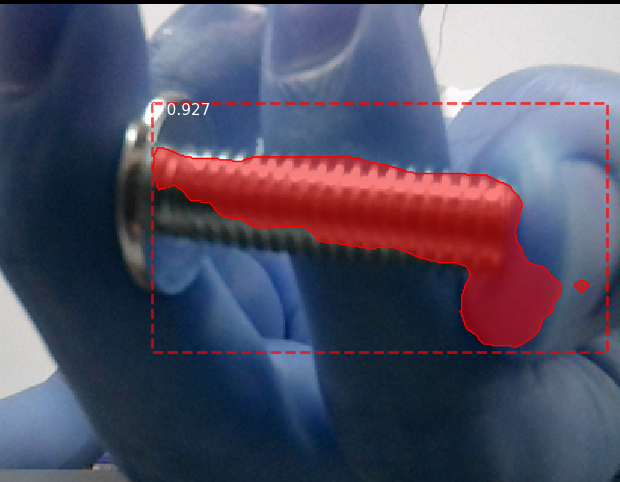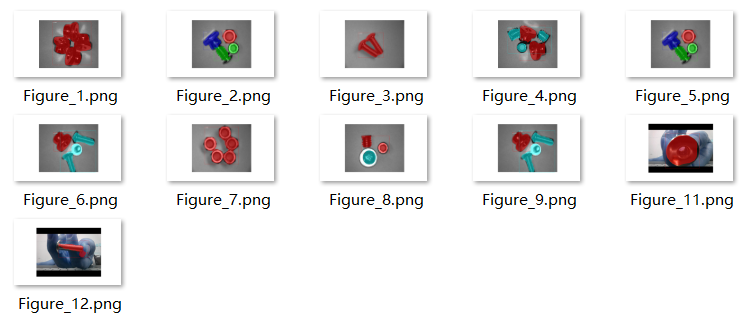1、首先从官方下载mask_rcnn源码https://github.com/matterport/Mask_RCNN
2、当制作自己的数据集的时候,图片的大小一定要记得修改,长宽都要修改为修改为2的6次方的倍数,不然训练的时候会报错,来看源代码:

2、首先将demo.ipynb转换成demo.py,这里我顺便更改为适用于我自己数据集:
import os import sys import random import math import numpy as np import skimage.io import matplotlib import matplotlib.pyplot as plt import cv2 import time from mrcnn.config import Config from datetime import datetime # Root directory of the project ROOT_DIR = os.path.abspath("../") # Import Mask RCNN sys.path.append(ROOT_DIR) # To find local version of the library from mrcnn import utils import mrcnn.model as modellib from mrcnn import visualize # Import COCO config sys.path.append(os.path.join(ROOT_DIR, "samples/coco/")) # To find local version import coco # Directory to save logs and trained model MODEL_DIR = os.path.join(ROOT_DIR, "logs/shapes20190425T0816") # Local path to trained weights file COCO_MODEL_PATH = os.path.join(MODEL_DIR ,"mask_rcnn_shapes_0030.h5") # Download COCO trained weights from Releases if needed if not os.path.exists(COCO_MODEL_PATH): utils.download_trained_weights(COCO_MODEL_PATH) print("cuiwei***********************") # Directory of images to run detection on IMAGE_DIR = os.path.join(ROOT_DIR, "images") class ShapesConfig(Config): """Configuration for training on the toy shapes dataset. Derives from the base Config class and overrides values specific to the toy shapes dataset. """ # Give the configuration a recognizable name NAME = "shapes" # Train on 1 GPU and 8 images per GPU. We can put multiple images on each # GPU because the images are small. Batch size is 8 (GPUs * images/GPU). GPU_COUNT = 1 IMAGES_PER_GPU = 1 # Number of classes (including background) NUM_CLASSES = 1 + 4 # background + 3 shapes # Use small images for faster training. Set the limits of the small side # the large side, and that determines the image shape. IMAGE_MIN_DIM = 320 IMAGE_MAX_DIM = 384 # Use smaller anchors because our image and objects are small RPN_ANCHOR_SCALES = (8 * 6, 16 * 6, 32 * 6, 64 * 6, 128 * 6) # anchor side in pixels # Reduce training ROIs per image because the images are small and have # few objects. Aim to allow ROI sampling to pick 33% positive ROIs. TRAIN_ROIS_PER_IMAGE =100 # Use a small epoch since the data is simple STEPS_PER_EPOCH = 100 # use small validation steps since the epoch is small VALIDATION_STEPS = 50 class InferenceConfig(ShapesConfig): # Set batch size to 1 since we'll be running inference on # one image at a time. Batch size = GPU_COUNT * IMAGES_PER_GPU GPU_COUNT = 1 IMAGES_PER_GPU = 1 config = InferenceConfig() config.display() # Create model object in inference mode. model = modellib.MaskRCNN(mode="inference", model_dir=MODEL_DIR, config=config) # Load weights trained on MS-COCO model.load_weights(COCO_MODEL_PATH, by_name=True) # COCO Class names # Index of the class in the list is its ID. For example, to get ID of # the teddy bear class, use: class_names.index('teddy bear') class_names = ['BG', 'a','b','c','e'] # Load a random image from the images folder #file_names = next(os.walk(IMAGE_DIR))[2] #image = skimage.io.imread(os.path.join(IMAGE_DIR, random.choice(file_names))) cap = cv2.VideoCapture(0) while(1): # get a frame ret, frame = cap.read() # show a frame start =time.clock() results = model.detect([frame], verbose=1) r = results[0] #cv2.imshow("capture", frame) visualize.display_instances(frame, r['rois'], r['masks'], r['class_ids'], class_names, r['scores']) end = time.clock() print(end-start) if cv2.waitKey(1) & 0xFF == ord('q'): break cap.release() cv2.destroyAllWindows() #image= cv2.imread("C:\Users\18301\Desktop\Mask_RCNN-master\images\9.jpg") ## Run detection # #results = model.detect([image], verbose=1) # #print(end-start) ## Visualize results #r = results[0] #visualize.display_instances(image, r['rois'], r['masks'], r['class_ids'], # class_names, r['scores'])
以上这段代码可以调用摄像头拍摄图片进行目标识别。


以下为训练文件:
# -*- coding: utf-8 -*- import os import sys import random import math import re import time import numpy as np import cv2 import matplotlib import matplotlib.pyplot as plt import tensorflow as tf from mrcnn.config import Config #import utils from mrcnn import model as modellib,utils from mrcnn import visualize import yaml from mrcnn.model import log from PIL import Image #os.environ["CUDA_VISIBLE_DEVICES"] = "0" # Root directory of the project ROOT_DIR = os.getcwd() #ROOT_DIR = os.path.abspath("../") # Directory to save logs and trained model MODEL_DIR = os.path.join(ROOT_DIR, "logs") iter_num=0 # Local path to trained weights file COCO_MODEL_PATH = os.path.join(ROOT_DIR, "mask_rcnn_coco.h5") # Download COCO trained weights from Releases if needed if not os.path.exists(COCO_MODEL_PATH): utils.download_trained_weights(COCO_MODEL_PATH) class ShapesConfig(Config): """Configuration for training on the toy shapes dataset. Derives from the base Config class and overrides values specific to the toy shapes dataset. """ # Give the configuration a recognizable name NAME = "shapes" # Train on 1 GPU and 8 images per GPU. We can put multiple images on each # GPU because the images are small. Batch size is 8 (GPUs * images/GPU). GPU_COUNT = 1 IMAGES_PER_GPU = 1 # Number of classes (including background) NUM_CLASSES = 1 + 4 # background + 3 shapes # Use small images for faster training. Set the limits of the small side # the large side, and that determines the image shape. IMAGE_MIN_DIM = 320 IMAGE_MAX_DIM = 384 # Use smaller anchors because our image and objects are small RPN_ANCHOR_SCALES = (8 * 6, 16 * 6, 32 * 6, 64 * 6, 128 * 6) # anchor side in pixels # Reduce training ROIs per image because the images are small and have # few objects. Aim to allow ROI sampling to pick 33% positive ROIs. TRAIN_ROIS_PER_IMAGE = 100 # Use a small epoch since the data is simple STEPS_PER_EPOCH = 100 # use small validation steps since the epoch is small VALIDATION_STEPS = 50 config = ShapesConfig() config.display() class DrugDataset(utils.Dataset): # 得到该图中有多少个实例(物体) def get_obj_index(self, image): n = np.max(image) return n # 解析labelme中得到的yaml文件,从而得到mask每一层对应的实例标签 def from_yaml_get_class(self, image_id): info = self.image_info[image_id] with open(info['yaml_path']) as f: temp = yaml.load(f.read()) labels = temp['label_names'] del labels[0] return labels # 重新写draw_mask def draw_mask(self, num_obj, mask, image,image_id): #print("draw_mask-->",image_id) #print("self.image_info",self.image_info) info = self.image_info[image_id] #print("info-->",info) #print("info[width]----->",info['width'],"-info[height]--->",info['height']) for index in range(num_obj): for i in range(info['width']): for j in range(info['height']): #print("image_id-->",image_id,"-i--->",i,"-j--->",j) #print("info[width]----->",info['width'],"-info[height]--->",info['height']) at_pixel = image.getpixel((i, j)) if at_pixel == index + 1: mask[j, i, index] = 1 return mask # 重新写load_shapes,里面包含自己的自己的类别 # 并在self.image_info信息中添加了path、mask_path 、yaml_path # yaml_pathdataset_root_path = "/tongue_dateset/" # img_floder = dataset_root_path + "rgb" # mask_floder = dataset_root_path + "mask" # dataset_root_path = "/tongue_dateset/" def load_shapes(self, count, img_floder, mask_floder, imglist, dataset_root_path): """Generate the requested number of synthetic images. count: number of images to generate. height, the size of the generated images. """ # Add classes self.add_class("shapes", 1, "a") self.add_class("shapes", 2, "b") self.add_class("shapes", 3, "c") self.add_class("shapes", 4, "e") for i in range(count): # 获取图片宽和高 filestr = imglist[i].split(".")[0] #print(imglist[i],"-->",cv_img.shape[1],"--->",cv_img.shape[0]) #print("id-->", i, " imglist[", i, "]-->", imglist[i],"filestr-->",filestr) # filestr = filestr.split("_")[1] mask_path = mask_floder + "/" + filestr + ".png" yaml_path = dataset_root_path + "labelme_json/" + filestr + "_json/info.yaml" print(dataset_root_path + "labelme_json/" + filestr + "_json/img.png") cv_img = cv2.imread(dataset_root_path + "labelme_json/" + filestr + "_json/img.png") self.add_image("shapes", image_id=i, path=img_floder + "/" + imglist[i], width=cv_img.shape[1], height=cv_img.shape[0], mask_path=mask_path, yaml_path=yaml_path) # 重写load_mask def load_mask(self, image_id): """Generate instance masks for shapes of the given image ID. """ global iter_num print("image_id",image_id) info = self.image_info[image_id] count = 1 # number of object img = Image.open(info['mask_path']) num_obj = self.get_obj_index(img) mask = np.zeros([info['height'], info['width'], num_obj], dtype=np.uint8) mask = self.draw_mask(num_obj, mask, img,image_id) occlusion = np.logical_not(mask[:, :, -1]).astype(np.uint8) for i in range(count - 2, -1, -1): mask[:, :, i] = mask[:, :, i] * occlusion occlusion = np.logical_and(occlusion, np.logical_not(mask[:, :, i])) labels = [] labels = self.from_yaml_get_class(image_id) labels_form = [] for i in range(len(labels)): if labels[i].find("a") != -1: labels_form.append("a") elif labels[i].find("b") != -1: labels_form.append("b") elif labels[i].find("c") != -1: labels_form.append("c") elif labels[i].find("e") != -1: labels_form.append("e") class_ids = np.array([self.class_names.index(s) for s in labels_form]) return mask, class_ids.astype(np.int32) def get_ax(rows=1, cols=1, size=8): """Return a Matplotlib Axes array to be used in all visualizations in the notebook. Provide a central point to control graph sizes. Change the default size attribute to control the size of rendered images """ _, ax = plt.subplots(rows, cols, figsize=(size * cols, size * rows)) return ax #基础设置 dataset_root_path="train_data/" img_floder = dataset_root_path + "pic" mask_floder = dataset_root_path + "cv2_mask" #yaml_floder = dataset_root_path imglist = os.listdir(img_floder) count = len(imglist) #train与val数据集准备 dataset_train = DrugDataset() dataset_train.load_shapes(count, img_floder, mask_floder, imglist,dataset_root_path) dataset_train.prepare() #print("dataset_train-->",dataset_train._image_ids) dataset_val = DrugDataset() dataset_val.load_shapes(7, img_floder, mask_floder, imglist,dataset_root_path) dataset_val.prepare() #print("dataset_val-->",dataset_val._image_ids) # Load and display random samples #image_ids = np.random.choice(dataset_train.image_ids, 4) #for image_id in image_ids: # image = dataset_train.load_image(image_id) # mask, class_ids = dataset_train.load_mask(image_id) # visualize.display_top_masks(image, mask, class_ids, dataset_train.class_names) # Create model in training mode model = modellib.MaskRCNN(mode="training", config=config, model_dir=MODEL_DIR) # Which weights to start with? init_with = "coco" # imagenet, coco, or last if init_with == "imagenet": model.load_weights(model.get_imagenet_weights(), by_name=True) elif init_with == "coco": # Load weights trained on MS COCO, but skip layers that # are different due to the different number of classes # See README for instructions to download the COCO weights model.load_weights(COCO_MODEL_PATH, by_name=True, exclude=["mrcnn_class_logits", "mrcnn_bbox_fc", "mrcnn_bbox", "mrcnn_mask"]) elif init_with == "last": # Load the last model you trained and continue training model.load_weights(model.find_last()[1], by_name=True) # Train the head branches # Passing layers="heads" freezes all layers except the head # layers. You can also pass a regular expression to select # which layers to train by name pattern. model.train(dataset_train, dataset_val, learning_rate=config.LEARNING_RATE, epochs=10, layers='heads') # Fine tune all layers # Passing layers="all" trains all layers. You can also # pass a regular expression to select which layers to # train by name pattern. model.train(dataset_train, dataset_val, learning_rate=config.LEARNING_RATE / 10, epochs=30, layers="all")
以下为测试代码:
# -*- coding: utf-8 -*- import os import sys import random import math import numpy as np import skimage.io import matplotlib import matplotlib.pyplot as plt import cv2 import time from mrcnn.config import Config from datetime import datetime # Root directory of the project ROOT_DIR = os.getcwd() # Import Mask RCNN sys.path.append(ROOT_DIR) # To find local version of the library from mrcnn import utils import mrcnn.model as modellib from mrcnn import visualize # Import COCO config sys.path.append(os.path.join(ROOT_DIR, "samples/coco/")) # To find local version from samples.coco import coco # Directory to save logs and trained model MODEL_DIR = os.path.join(ROOT_DIR, "logs/shapes20190425T0816/") # Local path to trained weights file COCO_MODEL_PATH = os.path.join(MODEL_DIR ,"mask_rcnn_shapes_0030.h5") # Download COCO trained weights from Releases if needed if not os.path.exists(COCO_MODEL_PATH): utils.download_trained_weights(COCO_MODEL_PATH) print("wancheng***********************") # Directory of images to run detection on IMAGE_DIR = os.path.join(ROOT_DIR, "images") class ShapesConfig(Config): """Configuration for training on the toy shapes dataset. Derives from the base Config class and overrides values specific to the toy shapes dataset. """ # Give the configuration a recognizable name NAME = "shapes" # Train on 1 GPU and 8 images per GPU. We can put multiple images on each # GPU because the images are small. Batch size is 8 (GPUs * images/GPU). GPU_COUNT = 1 IMAGES_PER_GPU = 1 # Number of classes (including background) NUM_CLASSES = 1 + 4 # background + 3 shapes # Use small images for faster training. Set the limits of the small side # the large side, and that determines the image shape. IMAGE_MIN_DIM = 320 IMAGE_MAX_DIM = 384 # Use smaller anchors because our image and objects are small RPN_ANCHOR_SCALES = (8 * 6, 16 * 6, 32 * 6, 64 * 6, 128 * 6) # anchor side in pixels # Reduce training ROIs per image because the images are small and have # few objects. Aim to allow ROI sampling to pick 33% positive ROIs. TRAIN_ROIS_PER_IMAGE =100 # Use a small epoch since the data is simple STEPS_PER_EPOCH = 100 # use small validation steps since the epoch is small VALIDATION_STEPS = 50 #import train_tongue #class InferenceConfig(coco.CocoConfig): class InferenceConfig(ShapesConfig): # Set batch size to 1 since we'll be running inference on # one image at a time. Batch size = GPU_COUNT * IMAGES_PER_GPU GPU_COUNT = 1 IMAGES_PER_GPU = 1 config = InferenceConfig() model = modellib.MaskRCNN(mode="inference", model_dir=MODEL_DIR, config=config) # Create model object in inference mode. model = modellib.MaskRCNN(mode="inference", model_dir=MODEL_DIR, config=config) # Load weights trained on MS-COCO model.load_weights(COCO_MODEL_PATH, by_name=True) # COCO Class names # Index of the class in the list is its ID. For example, to get ID of # the teddy bear class, use: class_names.index('teddy bear') class_names = ['BG', 'a','b','c','e'] # Load a random image from the images folder file_names = next(os.walk(IMAGE_DIR))[2] image = skimage.io.imread(os.path.join(IMAGE_DIR, random.choice(file_names))) a=datetime.now() # Run detection results = model.detect([image], verbose=1) b=datetime.now() # Visualize results print("shijian",(b-a).seconds) r = results[0] visualize.display_instances(image, r['rois'], r['masks'], r['class_ids'], class_names, r['scores']) # Load a random image from the images folder #file_names = next(os.walk(IMAGE_DIR))[2] #image = skimage.io.imread(os.path.join(IMAGE_DIR, random.choice(file_names))) #cap = cv2.VideoCapture(0) # #while(1): # # get a frame # ret, frame = cap.read() # # show a frame # start =time.clock() # results = model.detect([frame], verbose=1) # r = results[0] # #cv2.imshow("capture", frame) # visualize.display_instances(frame, r['rois'], r['masks'], r['class_ids'], # class_names, r['scores']) # end = time.clock() # print(end-start) # if cv2.waitKey(1) & 0xFF == ord('q'): # break # #cap.release() #cv2.destroyAllWindows() #image= cv2.imread("C:\Users\18301\Desktop\Mask_RCNN-master\images\9.jpg") ## Run detection # #results = model.detect([image], verbose=1) # #print(end-start) ## Visualize results #r = results[0] #visualize.display_instances(image, r['rois'], r['masks'], r['class_ids'], # class_names, r['scores']) ## Root directory of the project #ROOT_DIR = os.getcwd() # ## Directory to save logs and trained model #MODEL_DIR = os.path.join(ROOT_DIR, "logs/shapes20180713T1554") # ## Local path to trained weights file #COCO_MODEL_PATH = os.path.join(ROOT_DIR, "mask_rcnn_coco.h5") ## Download COCO trained weights from Releases if needed #if not os.path.exists(COCO_MODEL_PATH): # utils.download_trained_weights(COCO_MODEL_PATH) # ## Directory of images to run detection on #IMAGE_DIR = os.path.join(ROOT_DIR, "images") # #class ShapesConfig(Config): # """Configuration for training on the toy shapes dataset. # Derives from the base Config class and overrides values specific # to the toy shapes dataset. # """ # # Give the configuration a recognizable name # NAME = "shapes" # # # Train on 1 GPU and 8 images per GPU. We can put multiple images on each # # GPU because the images are small. Batch size is 8 (GPUs * images/GPU). # GPU_COUNT = 1 # IMAGES_PER_GPU = 1 # # # Number of classes (including background) # NUM_CLASSES = 1 + 1 # background + 3 shapes # # # Use small images for faster training. Set the limits of the small side # # the large side, and that determines the image shape. # IMAGE_MIN_DIM = 320 # IMAGE_MAX_DIM = 384 # # # Use smaller anchors because our image and objects are small # RPN_ANCHOR_SCALES = (8 * 6, 16 * 6, 32 * 6, 64 * 6, 128 * 6) # anchor side in pixels # # # Reduce training ROIs per image because the images are small and have # # few objects. Aim to allow ROI sampling to pick 33% positive ROIs. # TRAIN_ROIS_PER_IMAGE =100 # # # Use a small epoch since the data is simple # STEPS_PER_EPOCH = 100 # # # use small validation steps since the epoch is small # VALIDATION_STEPS = 50 # ##import train_tongue ##class InferenceConfig(coco.CocoConfig): #class InferenceConfig(ShapesConfig): # # Set batch size to 1 since we'll be running inference on # # one image at a time. Batch size = GPU_COUNT * IMAGES_PER_GPU # GPU_COUNT = 1 # IMAGES_PER_GPU = 1 # #config = InferenceConfig() # #model = modellib.MaskRCNN(mode="inference", model_dir=MODEL_DIR, config=config) # ## Load weights trained on MS-COCO ## model.load_weights(COCO_MODEL_PATH, by_name=True) #model_path = model.find_last()[0] # ## Load trained weights (fill in path to trained weights here) #assert model_path != "", "Provide path to trained weights" #print("Loading weights from ", model_path) #model.load_weights(model_path, by_name=True) # #class_names = ['BG', 'tank'] # ## Load a random image from the images folder #file_names = next(os.walk(IMAGE_DIR))[2] #image = skimage.io.imread(os.path.join(IMAGE_DIR, random.choice(file_names))) # ## Run detection #results = model.detect([image], verbose=1) # ## Visualize results #r = results[0] #visualize.display_instances(image, r['rois'], r['masks'], r['class_ids'], # class_names, r['scores'])
修改代码中的路径及数据集即可正常训练出自己的数据集
